Abstract
Reusing or recycling waste into new useful materials is essential for environmental protection. Herein, we used discarded polystyrene (PS) and fly-ash (FA) particles and a fabricated fly-ash incorporated polystyrene fiber (FA/PS fiber) composite. The electrospinning process produced continuous PS fibers with a good distribution of FA particles. The prepared nanofibers were characterized by state-of-the-art techniques. The performances of the composite nanofibers were tested for fire-retardant applications. We observed that the incorporation of FA particles into the PS fibers led to an improvement in the performance of the composite as compared to the pristine PS fibers. This study showed an important strategy in using waste materials to produce functional nanofibers through an economical procedure. We believe that the strategy presented in this paper can be extended to other waste materials for obtaining nanofiber membranes for various environmental applications.
1. Introduction
In recent years, environmental pollution due to several types of waste materials coming from various industrial activities has caused serious problems for the Earth’s entire living population. Every year, tons of new industrial compounds are produced, which are sometimes released into ecosystems. Plastic waste has especially caused enormous environmental pollution because of its non-degradability under natural conditions [1]. Among the highly used plastic materials, polystyrene (PS), one of the promising thermoplastic polymers, is known for its high insulation properties [2]. It has been extensively explored in a variety of applications such as household applications, packaging, consumer electronic products, building and construction, and oil–water separation [3,4,5,6,7,8]. The outstanding features of PS, such as being odorless, colorless, low density, having thermal stability, and its inherent hydrophobic property, make it a promising candidate for various commercial products [9]. Due to the presence of phenyl groups and carbon–carbon (C–C) bonds, polystyrene is highly rigid and resistant to decomposition [10]. Therefore, it is difficult to recycle and reuse PS. Additionally, the recycling process is costly, and there is a very low economic return [11].
Fly ash (FA), a by-product of thermal power plants, is partly used in concrete and cement manufacturing, whereas a large quantity of it is disposed of in landfills [12]. The huge production of FA is extremely worrying because it may cause air and water pollution if it is not disposed of properly [13]. It is primarily composed of several metal oxides such as silica (SiO2), alumina (Al2O3), calcium oxide (CaO), magnesium oxide (MgO), iron oxide (Fe2O3), titania (TiO2), etc. [13,14]. Recently, several investigations have been performed to exploit FA for other applications such as water purification, filtration, adsorption, etc. [13,14,15,16]. Since FA possesses excellent adsorption properties, it has been used as an adsorbent for the removal of organic pollutants and heavy metal ions from water [13,17,18,19].
Over the past decade, there has been a growing emphasis on the utilization of waste materials for environmental and energy applications. Great approaches have been made through various strategies to use waste materials efficiently. Fabricating novel architectures from the discarded waste materials by applying the nanotechnological approach may provide a solution for environmental remediation [20,21]. Nanomaterials offer several amazing characteristics that are superior to that of bulk materials. Currently, electrospinning is considered as the best method for producing continuous nanofibers from various polymer solutions for wide areas of applications such as water treatment, biomedicals, fire-retardant, energy storage, etc. [22,23,24,25,26]. In this regard, several research groups have developed PS nanofibers by an electrospinning technique and applied it for various environmental applications [27,28,29,30,31,32].
Although fire has become an important part of human civilization, it is a major hazard to human life, property, and the environment. Besides the fatal heat levels, the toxic gases or chemicals liberated during a fire also affect the respiratory system and can lead to death. Therefore, there is an urgent need to design and develop cheap and environmentally friendly fire-retardant materials. Electrospun nanofiber membranes can be a good choice for designing such a fire-retardant material, as the nanofibers possess several outstanding characteristics such as flexibility, good mechanical properties, high surface area, porosity, etc. Unfortunately, most of the electrospun nanofibers in the pristine form are combustible. Although the introduction of a halogen- or phosphorus-based flame retardant is the common method of improving the flame retardancy of the materials, the limiting factor is the toxicity of the combustion products from a halogen-based flame retardants. A phosphorous-based flame retardant may be required in large amounts, which not only causes difficulties in the electrospinning process, but also affects the mechanical properties of the fibers [33,34,35]. Therefore, there is an urgent need for modifications to obtain flame retardant derivatives. In recent years, few studies have reported on the development of a fire-retardant nanofiber membrane by incorporating other materials such as nanoclay, metal oxide nanoparticles, graphene, carbon nanotubes (CNTs), etc., into nanofibers [36,37,38,39]. For example, Wu et al. synthesized flame retardant nylon-6 fibers containing montmorillonite clay by an electrospinning technique [40]. Pethsangave et al. prepared phosphorus-functionalized polyaniline and polypyrrole-supported graphene nanocomposites, which showed excellent flame-retardant properties when coated with cotton fabric and wood [41]. Recently, Kang et al. developed thermally oxidized polyacrylonitrile/polyvinylpyrrolidone/SiO2 nanofibers as an effective flame-retardant membrane [42]. Thus, the addition of nanofillers can be considered as an alternative approach to improve the fire-retardant performance of electrospun nanofiber membranes [42,43,44].
The utilization of discarded materials as a nanofiber precursor in electrospinning not only provides a remedy for environmental pollution, but also is cost-effective since the discarded materials are freely available [45,46]. Based on these understandings, herein, we used two waste materials (discarded PS and FA particles) to prepare FA-incorporated PS fibers. The as-prepared fiber composite was characterized with various techniques and tested for fire-retardant performance. The strategy presented in this work provides a new approach to using discarded materials for various applications such as a fire-retardant, food packaging, filtration, etc.
2. Experimental
2.1. Materials
The discarded polystyrene (PS) was collected from the Woosuk University area in Samnye, Jeollabuk-do, South Korea. N,N-Dimethylformamide (DMF) was obtained from Sigma-Aldrich. Purified FA particles were obtained from the Won Engineering Company Ltd., Gunsan, Korea.
2.2. Fabrication of FA NPs Incorporated PS Fibers
In the beginning, the FA particles were ball-milled by using 3 mm zirconia balls and sieved for 12 h. A certain amount of ball-milled FA particle was dispersed into the DMF and subjected to sonication for 6 h followed by stirring for 6 h at room temperature. Next, 4 g of discarded PS was added to the above suspension and stirred overnight. The concentration of PS was adjusted to 20%. After obtaining a clear solution, electrospinning was performed at room temperature. During the electrospinning, 20 kV was applied, and the tip-to-collector distance was maintained at 15 cm. The as-spun nanofiber mat was vacuum dried at 40 °C for 12 h. For comparison, a pristine PS fiber mat was also prepared in the aforementioned conditions without using FA. The obtained nanofiber mats were characterized with various techniques. Figure 1 represents the synthetic protocol for the fabrication of the FA/PS fiber composite.
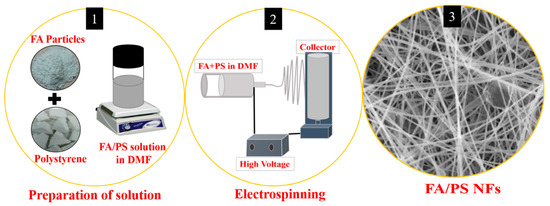
Figure 1.
Schematic diagram showing the fabrication of the FA/PS fiber composite.
2.3. Characterization
The morphologies of the as-prepared nanofibers were investigated by field-emission scanning electron microscopy (FESEM, S-7400, Hitachi, Tokyo, Japan). The average diameter of the nanofibers was determined by using ImageJ software (National Institute of Health, Bethesda, MD, USA). The conductivity of the electrospinning solutions was recorded with the Electrical conductivity meter (CM-42X, DKK-TOA Corporation, Tokyo, Japan). For crystallinity determination, an X-ray diffractometer (XRD) was used (Rigaku Co., Tokyo, Japan). The Fourier transform infrared (FTIR) spectra were recorded using an ABB Bomen MB100 Spectrometer (Bomen, Quebec, QC, Canada). Mechanical properties were studied by using a Universal Testing Machine (AG-5000G, Shimadzu, Kyoto, Japan). The thermal properties of the as-synthesized nanofibers were studied by thermogravimetric analysis (TGA, Perkin-Elmer, Akron, OH, USA).
2.4. Evaluation of Fire-Resistance Property
The limited oxygen index (LOI) method was employed to study the fire-retardant property of the as-prepared nanocomposite fibers. The LOI value of the fibers was tested by an M606B digital oxygen index instrument.
3. Results and Discussion
The morphological investigation was performed by field emission scanning electron microscopy (FE-SEM). Figure 2A depicts the morphology of ball-milled FA particles. FA is a heterogenous material that consists of small spheres of irregular, porous, coke-like particles. As in Figure 2A, the FA particles were irregular-shaped with various sizes. The chemical composition of the FA particles was confirmed by the EDS analysis. The EDS spectra of FA particles showed the presence of C, O, Mg, Al, Si, S, Cl, Ca, Ti, and Fe (Figure 2B). The XRD spectra identified mullite, calcite, and quartz as the major mineral constituents in FA (Figure 2C) [13,47].

Figure 2.
FESEM (A), EDS (B), XRD spectra (C) of FA particles.
The morphologies of electrospun PS fibers and the FA/PS composite are given in Figure 3A and Figure 3B, respectively. As in the figures, both samples showed a smooth and continuous fiber morphology without beads. The pristine PS solution resulted in the formation of the microfiber after electrospinning. The average diameter of the pristine PS fibers was 2–3 μm (Figure 3C). Interestingly, the diameter of the PS fibers was reduced to nanoscale after the addition of FA particles. The average diameter of FA/PS fibers was about 600–700 nm (Figure 3D). The nanoscale modification of fibers not only provides a higher surface area, but also widens its application to various fields. Many factors, such as solution concentration, applied voltage, flow rate, tip-to-collector distance, and solution properties (polarity, viscosity, conductivity), influence the diameters and morphology of the electrospun nanofibers [22]. The high reduction of the diameter in the case of composite fibers was attributed to the conductivity of the solution. The conductivity of the PS solution was approximately 2.01 mS/m, whereas it was increased to 2.66 mS/m after the addition of FS particles on it. The increase in the conductivity is attributed to the various metal oxide components of FA. It is well-known that higher conductivity results in the formation of thinner nanofibers. We have observed the same results in our previous studies also [48,49]. The FA/PS composite fibers showed a homogenous distribution of FA particles throughout the nanofibers.
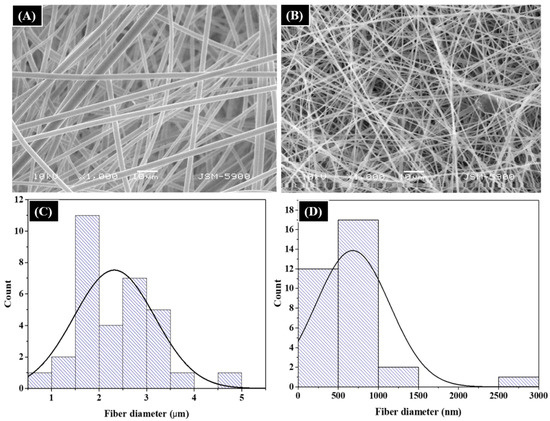
Figure 3.
SEM images of as-spun pristine PS fibers (A) and FA/PS fibers (B). (C,D) are the diameter distribution curves of PS fibers and FA/PS fibers, respectively.
To investigate the arrangement of FA particles in PS fibers, we captured FE-SEM images of the FA/PS composite (Figure 4). As in the figure, the FA particles were both attached to the surface of PS fibers and embedded within the fibers. It should be noted that the FA particles used in this study were in the nano to micro range (Figure 2A). Since the particles were well-dispersed in the PS solution prior to the electrospinning process, the nano-sized particles could be trapped inside the electrospun PS fibers (Figure 4B), while the larger particles were attached to the outer side of the fibers. We also observed a flat-structured FA flake attached to the PS fibers (Figure 4C). Although the size of the FA flake was larger than the diameter of the PS fibers, the flake was attached to the fibers with three connection points, indicating a strong bond with the fibers. This finding ensures the good dispersion of FA particles in PS solution and their interaction with the polymer nanofibers.
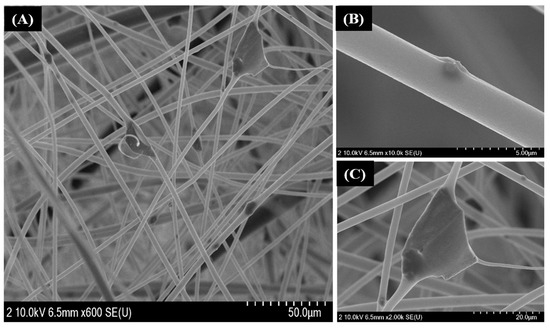
Figure 4.
FESEM image of FA/PS NFs membrane (A), FA particle embedded inside the PS NFs (B), and FA flake-like structure attached to the PS fibers (C).
The flexibility and the free-standing nature of the FA/PS composite membrane were studied with the folding test. The optical images of the as-prepared FA/PS fiber membrane during the folding tests are given in Figure 5A–E. As in the figure, the product could be folded repeatedly without any damage. Furthermore, the fiber morphology was investigated after being folded with an angle of 180° for one hundred times. There was no change in the fiber morphology. The fibers were preserved intact and showed continuous morphology even after the bending tests several times. The mechanical properties of the as-prepared FA/PS composite fiber membrane were compared with that of the pristine PS fiber membrane. As in Figure 4F, the composite resulted in improved mechanical properties compared to the pristine form. The tensile strength of ~0.23 MPa was recorded in the case of the PS fiber membrane, whereas the FA/PS composite fiber membrane exhibited ~0.34 MPa. The enhancement in the tensile strength is attributed to the role of FA particles in the fiber. The proper interaction between FA and polymer matrix (filler–polymer interaction) is important for a strong nanofiber membrane. The addition of FA particles alters the morphology of the nanofiber membrane. The diameter of the nanofiber was reduced from micro to nanoscale when FA particles were added to the system. The distribution of FA particles in the nano-scaled fibers can substantially improve the mechanical properties of the FA/PS composite fibers due to their large interfacial area, which enables them to transfer an applied load through the filler (or matrix) interface [50,51].
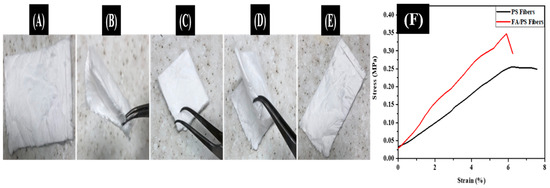
Figure 5.
(A) Optical images of as-prepared FA/PS membrane, (B) during folding, (C) folded with 180°, (D) during unfolding, and (E) after unfolding. (F) is the stress–strain curve of the as-prepared FA/PS fiber membrane compared to PS fiber membrane.
The crystal structure of as-prepared pristine PS and FA/PS fibers was evaluated by an XRD analysis. As shown in Figure 6A, the pristine PS showed two diffraction peaks approximately at 2θ value of 19.1 and 22°, which represents the (110) and (220) crystal planes, respectively [52,53]. For the FA/PS composite, the extra peaks were observed, which confirms the presence of FA particles on it [13]. FTIR spectra of electrospun PS NFs and FA/PS composite are presented in Figure 6B. In the IR spectra of FA, the marked peaks at about 460, 1098, and 1450 cm−1 are attributed to the Si–O–Al, Si–O–Si, H–O–H bands, respectively [47,54]. Pure PS showed three obvious characteristic absorption bands. The lower absorbance intensities at 3200–2800 cm−1 were assigned as C–H symmetric and asymmetric vibration. The wavenumber at 1600–1400 cm−1 corresponds to the bending vibration, and the stronger intensities around 770–650 cm−1 are attributed to the mono-substituted benzene [53]. The FA/PS composite showed almost similar peaks as pristine PS. An extra band near 460 cm−1 in FA/PS fibers (arrow in Figure 6B) is attributed to the FA in the composite sample [13]. The peak intensity in the FA/PS fibers is remarkably decreased compared to the pristine FA and PS, suggesting the homogenous deposition of FA into PS throughout the matrix [55].
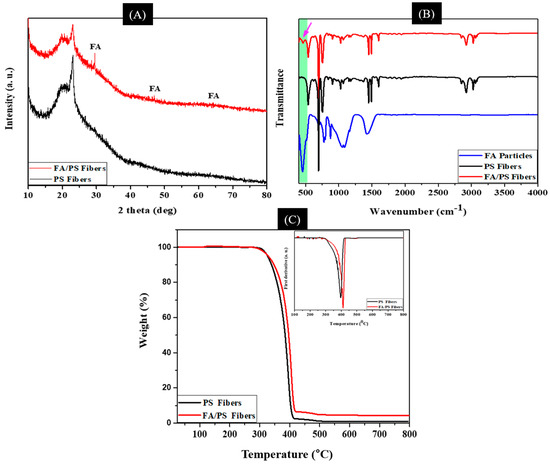
Figure 6.
XRD (A), FTIR (B), and TGA (C) of as-prepared samples. The inset in C represents the DTG curves of FA/PS composite membrane compared to that of the pristine PS fibers.
The thermal stability of the prepared samples was studied by thermogravimetric analysis (TGA). The TGA results in Figure 6C provide quantitative information on the incorporation of FA on PS fibers. The TGA profile showed a single-step decomposition in both cases. The degradation occurred around 330–418 °C. The pristine PS fibers showed a complete degradation around 500 °C; however, the FA/PS fibers showed about 6% residue, which is due to the presence of FA in the composite membrane. Additionally, the enhanced thermal property of the composite was verified by the DTG curves (Inset Figure 6C).
The limited oxygen index is considered as an excellent tool to quantify the flammability of polymeric materials. The LOI values for pristine PS fibers and FA/PS composite fibers were tested and are given in Figure 7. The PS fibers easily burn in air with black smoke. The limited oxygen index (LOI) value of the pristine PS NFs membrane was recorded at approximately 17%. When FA particles were added to the PS membrane, the membrane possessed an LOI value of ~24%. Further, we carried out an open flame test to access the flame-resistance of the as-prepared membranes (Figure 7B). For this study, the fiber membranes were cut into 1.5 cm × 8 cm and ignited into the air. The pristine PS membrane was ignited immediately with smoke when exposed to the fire source and burnt completely in 3 s. On the other hand, after removing from the fire source, the FA/PS composite membrane shrunk and self-extinguished in about 4 s, without a complete burn. This indicates the role of FA particles in the fire-retardant ability of the composite nanofiber membrane. Recently, Ma et. al. [56] have confirmed that active ingredients (such as Al3+, Fe3+, Ti4+, Mg2+, Ca2+, etc.) in FA can be released and transformed into effective components of fire prevention. The Fe2O3 present in FA forms a dense char layer by promoting the crosslinking of the polymer [57]. The strong interaction between FA particles and PS nanofibers promotes the heat resistance of the composite membrane, thereby enhancing the overall fire-retardant properties [58,59].
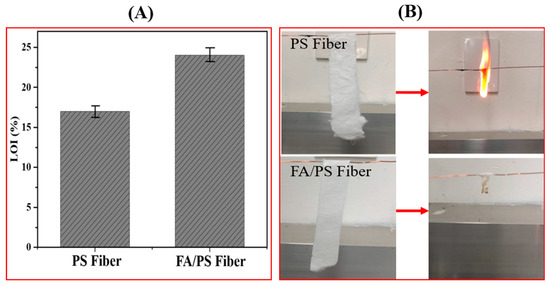
Figure 7.
Comparison between the LOI values (A) and flame test for PS fiber and FA/PS fiber membrane (B).
4. Conclusions
The utilization of waste materials such as discarded polystyrene and fly ash particles for designing fire-retardant materials has been introduced in this study. An FA-incorporated PS nanofiber membrane was synthesized by simply dispersing the FA particles in the PS solution followed by the electrospinning process. The as-obtained FA/PS composite showed good nanofiber morphology, along with good distribution of FA particles over the fibers. The performance of the samples was tested for fire-retardant properties, and it was observed that the fire-retardant behavior was enhanced after the addition of FA particles to the PS fibers. The strategy presented in this study highlights the utilization of waste materials, thereby addressing environmental issues. The major attributes of our study are the easy synthetic protocol at ambient conditions and finding out the possibilities of waste-based products in fire-retardant applications. Since the FA particles were well-embedded and attached to the surface of PS fibers, we believe that the as-obtained FA/PS fiber composite can also be applied to various other applications such as food packaging, photocatalysis, adsorption, filtration, etc.
Author Contributions
Conceptualization, B.P.; methodology, B.P. and O.H.K.; software, B.P., G.P.O., J.A., Y.-S.K. and J.-K.K.; validation, B.P. and M.P.; formal analysis, B.P.; investigation, B.P.; resources, M.P.; data curation, B.P., G.P.O., J.A., Y.-S.K. and O.H.K.; writing—original draft preparation, B.P.; writing—review and editing, B.P.; visualization, B.P., M.P. and H.-S.K.; supervision, M.P. and H.-S.K.; project administration, M.P.; funding acquisition, M.P. All authors have read and agreed to the published version of the manuscript.
Funding
This work was supported by the National Research Foundation of Korea (NRF) grant funded by the Korean government (MSIT) (No. NRF-2019R1A2C1004467). This work was also supported by the Korea Carbon Industry Promotion Agency funded by the Ministry of Trade, Industry & Energy of the Republic of Korea (No. G2820220800013).
Institutional Review Board Statement
Not applicable.
Informed Consent Statement
Not applicable.
Data Availability Statement
The data presented in this study are available on request from the corresponding author.
Conflicts of Interest
The authors declare no conflict of interest.
References
- Thompson, R.C.; Moore, C.J.; vom Saal, F.S.; Swan, S.H. Plastics, the environment and human health: Current consensus and future trends. Philos. Trans. R. Soc. B Biol. Sci. 2009, 364, 2153–2166. [Google Scholar] [CrossRef] [PubMed]
- Kik, K.; Bukowska, B.; Sicińska, P. Polystyrene nanoparticles: Sources, occurrence in the environment, distribution in tissues, accumulation and toxicity to various organisms. Environ. Pollut. 2020, 262, 114297. [Google Scholar] [CrossRef] [PubMed]
- Li, H.M.; Zhang, Q.G.; Guo, N.N.; Zhu, A.M.; Liu, Q.L. Ultrafine polystyrene nanofibers and its application in nanofibrous membranes. Chem. Eng. J. 2015, 264, 329–335. [Google Scholar] [CrossRef]
- Zhao, J.; Wang, G.; Zhu, W.; Xu, Z.; Zhang, A.; Dong, G.; Zhao, G. Ultra-light, super-insulating, and strong polystyrene/carbon nanofiber nanocomposite foams fabricated by microcellular foaming. Eur. Polym. J. 2022, 173, 111261. [Google Scholar] [CrossRef]
- Abolghasemi-Fakhri, L.; Ghanbarzadeh, B.; Dehghannya, J.; Abbasi, F.; Adun, P. Styrene monomer migration from polystyrene based food packaging nanocomposite: Effect of clay and ZnO nanoparticles. Food Chem. Toxicol. 2019, 129, 77–86. [Google Scholar] [CrossRef] [PubMed]
- Chalco-Sandoval, W.; Fabra, M.J.; López-Rubio, A.; Lagaron, J.M. Development of polystyrene-based films with temperature buffering capacity for smart food packaging. J. Food Eng. 2015, 164, 55–62. [Google Scholar] [CrossRef]
- Mostafa, M.; Kandile, N.G.; Mahmoud, M.K.; Ibrahim, H.M. Synthesis and characterization of polystyrene with embedded silver nanoparticle nanofibers to utilize as antibacterial and wound healing biomaterial. Heliyon 2022, 8, e08772. [Google Scholar] [CrossRef]
- Dolanský, J.; Henke, P.; Kubát, P.; Fraix, A.; Sortino, S.; Mosinger, J. Polystyrene Nanofiber Materials for Visible-Light-Driven Dual Antibacterial Action via Simultaneous Photogeneration of NO and O2(1Δg). ACS Appl. Mater. Interfaces 2015, 7, 22980–22989. [Google Scholar] [CrossRef]
- Mahmoud, M.E.; Abdou, A.E.H.; Ahmed, S.B. Conversion of Waste Styrofoam into Engineered Adsorbents for Efficient Removal of Cadmium, Lead and Mercury from Water. ACS Sustain. Chem. Eng. 2016, 4, 819–827. [Google Scholar] [CrossRef]
- Andrade, B.T.N.C.; Bezerra, A.C.D.S.; Calado, C.R. Adding value to polystyrene waste by chemically transforming it into sulfonated polystyrene. Matéria (Rio De Jan) 2019, 24. [Google Scholar] [CrossRef]
- de Paula, F.G.F.; de Castro, M.C.M.; Ortega, P.F.R.; Blanco, C.; Lavall, R.L.; Santamaría, R. High value activated carbons from waste polystyrene foams. Microporous Mesoporous Mater. 2018, 267, 181–184. [Google Scholar] [CrossRef]
- Xu, Y.; Hu, E.; Xu, D.; Guo, Q. Activation of peroxymonosulfate by bimetallic CoMn oxides loaded on coal fly ash-derived SBA-15 for efficient degradation of Rhodamine B. Sep. Purif. Technol. 2021, 274, 119081. [Google Scholar] [CrossRef]
- Pant, B.; Ojha, G.P.; Kim, H.-Y.; Park, M.; Park, S.-J. Fly-ash-incorporated electrospun zinc oxide nanofibers: Potential material for environmental remediation. Environ. Pollut. 2019, 245, 163–172. [Google Scholar] [CrossRef]
- Pant, H.R.; Kim, H.J.; Joshi, M.K.; Pant, B.; Park, C.H.; Kim, J.I.; Hui, K.S.; Kim, C.S. One-step fabrication of multifunctional composite polyurethane spider-web-like nanofibrous membrane for water purification. J. Hazard. Mater. 2014, 264, 25–33. [Google Scholar] [CrossRef] [PubMed]
- Li, H.; Marie Kirkelund, G. Pulsed stirring for energy efficiency improvements during electrodialytic extraction of As, Cd, Cr, Cu, Pb, and Zn from municipal solid waste incineration fly ash and air pollution control residue. Sep. Purif. Technol. 2022, 290, 120835. [Google Scholar] [CrossRef]
- Gao, M.; Ma, Q.; Lin, Q.; Chang, J.; Ma, H. Fabrication and adsorption properties of hybrid fly ash composites. Appl. Surf. Sci. 2017, 396, 400–411. [Google Scholar] [CrossRef]
- Mishra, A.; Tripathi, B.D. Utilization of fly ash in adsorption of heavy metals from wastewater. Toxicol. Environ. Chem. 2008, 90, 1091–1097. [Google Scholar] [CrossRef]
- Zhang, J.; Yan, M.; Sun, G.; Liu, K. Simultaneous removal of Cu(II), Cd(II), Cr(VI), and rhodamine B in wastewater using TiO2 nanofibers membrane loaded on porous fly ash ceramic support. Sep. Purif. Technol. 2021, 272, 118888. [Google Scholar] [CrossRef]
- Saud, P.S.; Pant, B.; Park, M.; Chae, S.-H.; Park, S.-J.; Ei-Newehy, M.; Al-Deyab, S.S.; Kim, H.-Y. Preparation and photocatalytic activity of fly ash incorporated TiO2 nanofibers for effective removal of organic pollutants. Ceram. Int. 2015, 41, 1771–1777. [Google Scholar] [CrossRef]
- Pant, B.; Park, M.; Kim, H.-Y.; Park, S.-J. CdS-TiO2 NPs decorated carbonized eggshell membrane for effective removal of organic pollutants: A novel strategy to use a waste material for environmental remediation. J. Alloys Compd. 2017, 699, 73–78. [Google Scholar] [CrossRef]
- Pant, B.; Ojha, G.P.; Acharya, J.; Park, M. Eggshell membrane templated synthesis of Ni/MoC decorated carbon fibers with good electrochemical behavior. Int. J. Hydrog. Energy 2021, 46, 2774–2782. [Google Scholar] [CrossRef]
- Pant, B.; Park, M.; Park, S.-J. Drug Delivery Applications of Core-Sheath Nanofibers Prepared by Coaxial Electrospinning: A Review. Pharmaceutics 2019, 11, 305. [Google Scholar] [CrossRef]
- Pant, B.; Prasad Ojha, G.; Acharya, J.; Park, M. Ag3PO4-TiO2-Carbon nanofiber Composite: An efficient Visible-light photocatalyst obtained from eelectrospinning and hydrothermal methods. Sep. Purif. Technol. 2021, 276, 119400. [Google Scholar] [CrossRef]
- Zhang, W.; He, Z.; Han, Y.; Jiang, Q.; Zhan, C.; Zhang, K.; Li, Z.; Zhang, R. Structural design and environmental applications of electrospun nanofibers. Compos. Part A Appl. Sci. Manuf. 2020, 137, 106009. [Google Scholar] [CrossRef] [PubMed]
- Vahabi, H.; Wu, H.; Saeb, M.R.; Koo, J.H.; Ramakrishna, S. Electrospinning for developing flame retardant polymer materials: Current status and future perspectives. Polymer 2021, 217, 123466. [Google Scholar] [CrossRef]
- Thenmozhi, S.; Dharmaraj, N.; Kadirvelu, K.; Kim, H.Y. Electrospun nanofibers: New generation materials for advanced applications. Mater. Sci. Eng. B 2017, 217, 36–48. [Google Scholar] [CrossRef]
- Datsyuk, V.; Trotsenko, S.; Peikert, K.; Höflich, K.; Wedel, N.; Allar, C.; Sick, T.; Deinhart, V.; Reich, S.; Krcmar, W. Polystyrene nanofibers for nonwoven porous building insulation materials. Eng. Rep. 2019, 1, e12037. [Google Scholar] [CrossRef]
- Zander, N.E.; Sweetser, D.; Cole, D.P.; Gillan, M. Formation of Nanofibers from Pure and Mixed Waste Streams Using Electrospinning. Ind. Eng. Chem. Res. 2015, 54, 9057–9063. [Google Scholar] [CrossRef]
- Ishita, I.; Singhal, R. Porous multi-channel carbon nanofiber electrodes using discarded polystyrene foam as sacrificial material for high-performance supercapacitors. J. Appl. Electrochem. 2020, 50, 809–820. [Google Scholar] [CrossRef]
- Liu, F.; Song, D.; Huang, X.; Xu, H. Electrospun polystyrene nanofibers as a novel adsorbent to transfer an organic phase from an aqueous phase. J. Sep. Sci. 2016, 39, 1326–1330. [Google Scholar] [CrossRef]
- Ghiasvand, S.; Rahmani, A.; Samadi, M.; Asgari, G.; Azizian, S.; Poormohammadi, A. Application of polystyrene nanofibers filled with sawdust as separator pads for separation of oil spills. Process Saf. Environ. Prot. 2021, 146, 161–168. [Google Scholar] [CrossRef]
- Lee, M.W.; An, S.; Latthe, S.S.; Lee, C.; Hong, S.; Yoon, S.S. Electrospun Polystyrene Nanofiber Membrane with Superhydrophobicity and Superoleophilicity for Selective Separation of Water and Low Viscous Oil. ACS Appl. Mater. Interfaces 2013, 5, 10597–10604. [Google Scholar] [CrossRef]
- Chen, Y.; Wang, W.; Qiu, Y.; Li, L.; Qian, L.; Xin, F. Terminal group effects of phosphazene-triazine bi-group flame retardant additives in flame retardant polylactic acid composites. Polym. Degrad. Stab. 2017, 140, 166–175. [Google Scholar] [CrossRef]
- Xiao, Y.; Yang, Y.; Luo, Q.; Tang, B.; Guan, J.; Tian, Q. Construction of carbon-based flame retardant composite with reinforced and toughened property and its application in polylactic acid. RSC Adv. 2022, 12, 22236–22243. [Google Scholar] [CrossRef] [PubMed]
- Qiu, S.; Sun, J.; Li, H.; Gu, X.; Fei, B.; Zhang, S. A green way to simultaneously enhance the mechanical, flame retardant and anti-ultraviolet aging properties of polylactide composites by the incorporation of tannic acid derivatives. Polym. Degrad. Stab. 2022, 196, 109831. [Google Scholar] [CrossRef]
- Xia, Z.; Kiratitanavit, W.; Facendola, P.; Thota, S.; Yu, S.; Kumar, J.; Mosurkal, R.; Nagarajan, R. Fire resistant polyphenols based on chemical modification of bio-derived tannic acid. Polym. Degrad. Stab. 2018, 153, 227–243. [Google Scholar] [CrossRef]
- Kim, Y.N.; Ha, Y.-M.; Park, J.E.; Kim, Y.-O.; Jo, J.Y.; Han, H.; Lee, D.C.; Kim, J.; Jung, Y.C. Flame retardant, antimicrobial, and mechanical properties of multifunctional polyurethane nanofibers containing tannic acid-coated reduced graphene oxide. Polym. Test. 2021, 93, 107006. [Google Scholar] [CrossRef]
- Kim, Y.-G.; Kim, H.S.; Jo, S.M.; Kim, S.Y.; Yang, B.J.; Cho, J.; Lee, S.; Cha, J.E. Thermally insulating, fire-retardant, smokeless and flexible polyvinylidene fluoride nanofibers filled with silica aerogels. Chem. Eng. J. 2018, 351, 473–481. [Google Scholar] [CrossRef]
- Dhineshbabu, N.R.; Karunakaran, G.; Suriyaprabha, R.; Manivasakan, P.; Rajendran, V. Electrospun MgO/Nylon 6 Hybrid Nanofibers for Protective Clothing. Nano-Micro Lett. 2014, 6, 46–54. [Google Scholar] [CrossRef]
- Wu, H.; Krifa, M.; Koo, J.H. Flame retardant polyamide 6/nanoclay/intumescent nanocomposite fibers through electrospinning. Text. Res. J. 2014, 84, 1106–1118. [Google Scholar] [CrossRef]
- Pethsangave, D.A.; Khose, R.V.; Wadekar, P.H.; Some, S. Novel Approach toward the Synthesis of a Phosphorus-Functionalized Polymer-Based Graphene Composite as an Efficient Flame Retardant. ACS Sustain. Chem. Eng. 2019, 7, 11745–11753. [Google Scholar] [CrossRef]
- Kang, Y.; Chen, J.; Feng, S.; Zhou, H.; Zhou, F.; Low, Z.-X.; Zhong, Z.; Xing, W. Efficient removal of high-temperature particulate matters via a heat resistant and flame retardant thermally-oxidized PAN/PVP/SnO2 nanofiber membrane. J. Membr. Sci. 2022, 662, 120985. [Google Scholar] [CrossRef]
- Kim, Y.; Lee, S.; Yoon, H. Fire-Safe Polymer Composites: Flame-Retardant Effect of Nanofillers. Polymers 2021, 13, 540. [Google Scholar] [CrossRef] [PubMed]
- Arumugaprabu, V.; Arunprasath, K.; Manikandan, V.; Kakur, N.; Ilangovan, S.; Naveen, D.C. Thermal Performance and Fire Resistance Studies on Filler Based Natural Fiber Polymer Composites-A Review. In Encyclopedia of Materials: Plastics and Polymers; Hashmi, M.S.J., Ed.; Elsevier: Oxford, UK, 2022; pp. 717–723. [Google Scholar] [CrossRef]
- Pant, B.; Ojha, G.P.; Acharya, J.; Pant, H.R.; Park, M. Lokta paper-derived free-standing carbon as a binder-free electrode material for high-performance supercapacitors. Sustain. Mater. Technol. 2022, 33, e00450. [Google Scholar] [CrossRef]
- Zulfi, A.; Ahmad Hapidin, D.; Saputra, C.; Sinta Mustika, W.; Miftahul Munir, M.; Khairurrijal, K. The Synthesis of Fiber Membranes from High-Impact Polystyrene (HIPS) Waste using Needleless Electrospinning as Air Filtration Media. Mater. Today Proc. 2019, 13, 154–159. [Google Scholar] [CrossRef]
- Kim, H.J.; Joshi, M.K.; Pant, H.R.; Kim, J.H.; Lee, E.; Kim, C.S. One-pot hydrothermal synthesis of multifunctional Ag/ZnO/fly ash nanocomposite. Colloids Surf. A Physicochem. Eng. Asp. 2015, 469, 256–262. [Google Scholar] [CrossRef]
- Pant, B.; Pant, H.R.; Pandeya, D.R.; Panthi, G.; Nam, K.T.; Hong, S.T.; Kim, C.S.; Kim, H.Y. Characterization and antibacterial properties of Ag NPs loaded nylon-6 nanocomposite prepared by one-step electrospinning process. Colloids Surf. A Physicochem. Eng. Asp. 2012, 395, 94–99. [Google Scholar] [CrossRef]
- Pant, B.; Park, M.; Park, S.-J. One-Step Synthesis of Silver Nanoparticles Embedded Polyurethane Nano-Fiber/Net Structured Membrane as an Effective Antibacterial Medium. Polymers 2019, 11, 1185. [Google Scholar] [CrossRef]
- Kiran, M.D.; Govindaraju, H.K.; Jayaraju, T.; Kumar, N. Review-Effect of Fillers on Mechanical Properties of Polymer Matrix Composites. Mater. Today Proc. 2018, 5, 22421–22424. [Google Scholar] [CrossRef]
- Aveen, K.P.; Bhajantri, V.; D’Souza, R.; Londe, N.V.; Jambagi, S. Experimental analysis on effect of various fillers on mechanical properties of glass fiber reinforced polymer composites. AIP Conf. Proc. 2019, 2057, 020044. [Google Scholar] [CrossRef]
- Gowd, E.B.; Nair, S.S.; Ramesh, C. Crystalline Transitions of the Clathrate (δ) Form of Syndiotactic Polystyrene during Heating: Studies Using High-Temperature X-ray Diffraction. Macromolecules 2002, 35, 8509–8514. [Google Scholar] [CrossRef]
- Huan, S.; Bai, L.; Liu, G.; Cheng, W.; Han, G. Electrospun nanofibrous composites of polystyrene and cellulose nanocrystals: Manufacture and characterization. RSC Adv. 2015, 5, 50756–50766. [Google Scholar] [CrossRef]
- Khan, S.A.; Uddin, I.; Moeez, S.; Ahmad, A. Fungus-mediated preferential bioleaching of waste material such as fly-ash as a means of producing extracellular, protein capped, fluorescent and water soluble silica nanoparticles. PLoS ONE 2014, 9, e107597. [Google Scholar] [CrossRef] [PubMed]
- Yeole, K.; Kadam, P.; Mhaske, S. Synthesis and characterization of fly ash-zinc oxide nanocomposite. J. Mater. Res. Technol. 2014, 3, 186–190. [Google Scholar] [CrossRef]
- Ma, L.; Zhang, Y.; Wang, J.; Wang, J.; Zhou, C. Fire-Prevention Characteristics of an Active Colloid Prepared from Stimulated Fly Ash Component. ACS Omega 2022, 7, 1639–1647. [Google Scholar] [CrossRef] [PubMed]
- Li, B. A study of the thermal decomposition and smoke suppression of poly(vinyl chloride) treated with metal oxides using a cone calorimeter at a high incident heat flux. Polym. Degrad. Stab. 2002, 78, 349–356. [Google Scholar] [CrossRef]
- Soyama, M.; Inoue, K.; Iji, M. Flame retardancy of polycarbonate enhanced by adding fly ash. Polym. Adv. Technol. 2007, 18, 386–391. [Google Scholar] [CrossRef]
- Zhang, S.; Liu, W.; Yang, K.; Yu, W.; Zhu, F.; Zheng, Q. The Influence of Fly Ash on the Foaming Behavior and Flame Retardancy of Polyurethane Grouting Materials. Polymers 2022, 14, 1113. [Google Scholar] [CrossRef]
Publisher’s Note: MDPI stays neutral with regard to jurisdictional claims in published maps and institutional affiliations. |
© 2022 by the authors. Licensee MDPI, Basel, Switzerland. This article is an open access article distributed under the terms and conditions of the Creative Commons Attribution (CC BY) license (https://creativecommons.org/licenses/by/4.0/).